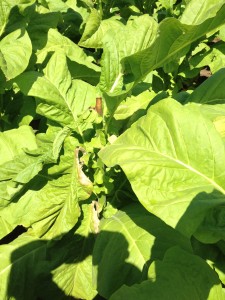Harvest is now underway on all farms. The quality of tobacco cured so far appears good. Pressure from aphids and hornworms does not appear to be too significant at this time in fields that were treated earlier. In higher rainfall areas, crops where additional nitrogen was applied appear to be gaining more colour. There are no widespread problems to report at this time.
As mentioned in an earlier post, leaf spotting from air pollutants (such as ozone) appears to be more general this year, especially in certain varieties such as CT572. To date, Potato Virus Y (PVY) is much less common in tobacco fields this year than last. Target Spot was evident earlier on the lower plant leaves and these leaves are now being harvested. In most cases, mid-stalk leaves appear to be minimally affected by this disease. There have been no reports of Blue Mold in Ontario. In the U.S., Blue Mold has been reported recently on tobacco in the states of Virginia and Massachusetts.
Currently, White Mould (Sclerotinia sclerotiorum) is being seen in a few fields. This disease can survive in the soil for several years even without a host. Planting tobacco after a susceptible crop, such as soybean or double cropping tobacco, should be avoided. Continuous cropping of a susceptible crop can lead to a greater amount of inoculum in the soil and greater incidence of the disease. For more information on White Mould, please refer to the technical bulletin entitled “Tobacco Pests and Disorders in the Field – White Mould” posted in the plant protection section under the research heading of this website.
Post prepared and sent by Canadian Tobacco Research Foundation
Mailing Address: CTRF, P.O. Box 322, Tillsonburg, ON N4G 4H5
Telephone: 519-842-8997
Web Address: http://ctrf1.com





